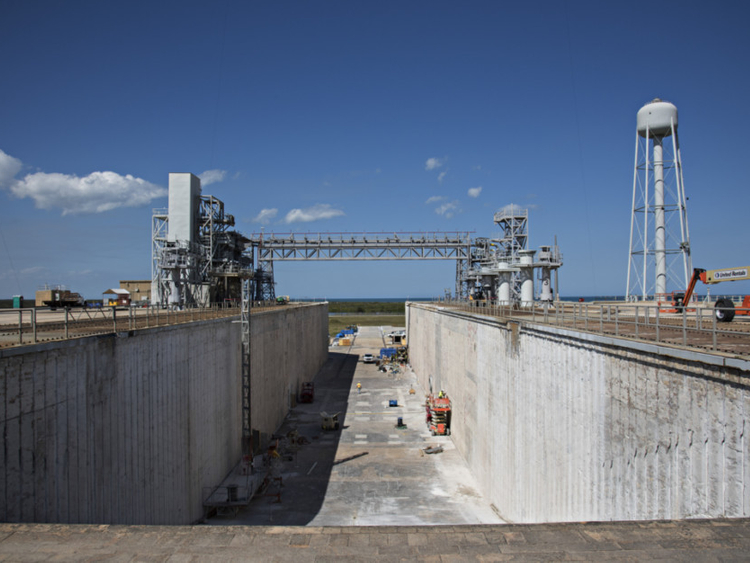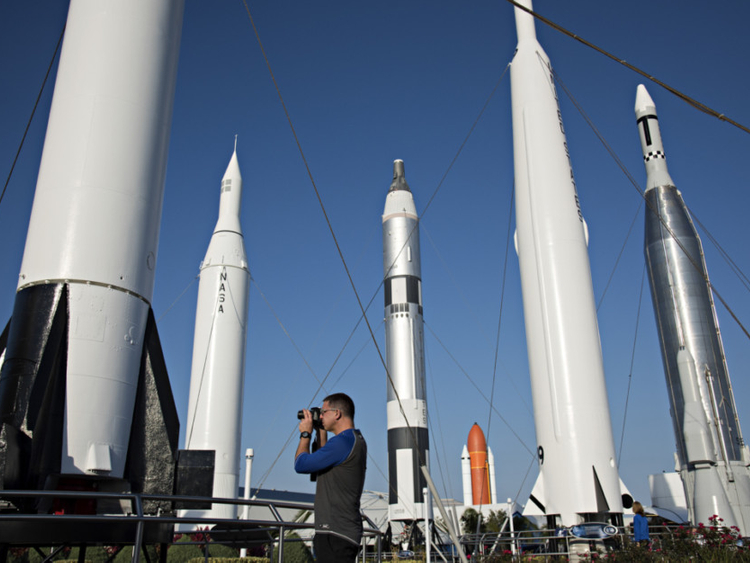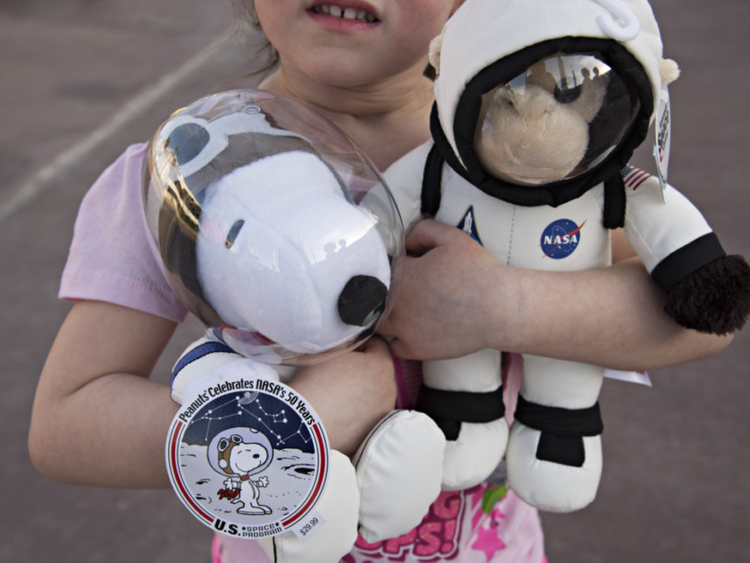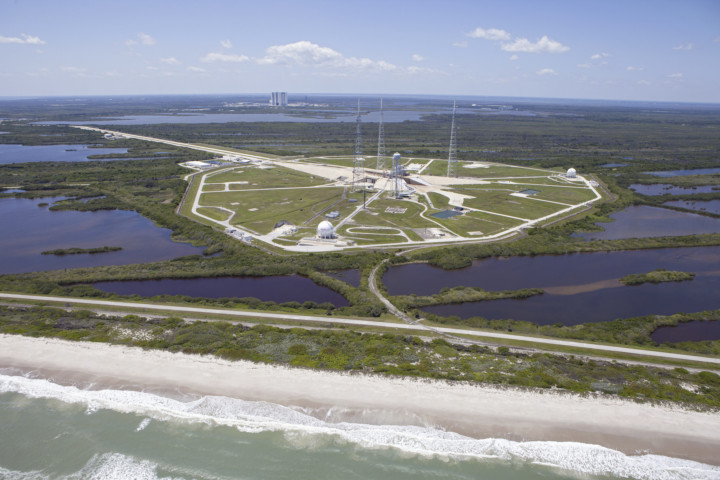
The concrete block perches absurdly atop a piling, elevated about 10 feet above the beach sand at Cape Canaveral, Florida. Is it art? A bulky milepost?
Carlton Hall pointed to the puzzling object and explained that it was once a tie-down block for securing structures such as antenna towers. Hall, the chief scientist for the Kennedy Space Center’s ecological programme, said that when he started working here a few decades ago, the block had been buried. Now the sand that enveloped it is gone, swept away by the forces of coastal erosion and storms.
He gestured towards the waves rolling in nearby and said, “The beach used to be at least 45 metres out.”
On the other side of the dunes, about 400 metres away, sit two artificial hills some 50 feet high. Those are Nasa’s two biggest launch pads. And to the south sit several smaller ones.
This is America’s busiest spaceport, and the water is coming.
Like so much of Florida, the Space Coast — a 116-kilometre stretch along the Atlantic — is feeling the threat of climate change. Some of the erosion is caused by the churning energy of ocean currents along the coastline. Hurricane Sandy, whose power was almost certainly strengthened by climate change, took a big bite in 2012, flattening an already damaged dune line that provided protection from the Atlantic’s battering.
A rising sea level will bring even greater risk over time — and perhaps sooner than most researchers expected. According to a study published earlier this month, warming pressure on the Antarctic ice sheet could help push sea levels higher by as much as five or six feet by the end of this century.
Nasa isn’t just a victim of climate change. It contributes to climate science in many ways, and not only in the data from the many satellites that orbit the planet after leaving Earth from here.
Its astronauts also help build awareness of the growing urgency of climate change. Astronaut Scott Kelly, who recently returned from nearly a year in space, took hundreds of photographs that could seem like abstract art or a dire warning; in an e-mail interview just before his descent, he said that he had seen changes in the planet even since his previous mission in 2010.
“It seems to me there is more pollution in India and China than what I saw last time,” he said. “Definitely noticed the fires this summer in the US; sometimes, could see the smoke all the way to Chicago.”
“Weather systems where they are not supposed to be obvious,” he added. “The fragility of the atmosphere always apparent.”
Pondering the problem
Nasa, which has at least $32 billion (Dh118 billion) worth of structures and facilities around the country, has been considering the possible effects of climate change for nearly a decade, said Kim W. Toufectis, a strategist who leads the master planning programme for the space agency.
Nasa, after all, is in the business of risk management. By 2007, “we had to acknowledge that we should recognise climate change and extreme weather as a formal risk that we should be actually managing,” Toufectis said.
With all of its expertise and its ability to make forecasts based on data, Toufectis added, “shame on us if we are not capitalising on that”.
In fact, Nasa’s climate risk extends far beyond Florida. About two-thirds of the land that Nasa manages is within five metres of mean sea level, and much of it is near the coasts.
“We are tremendously linked to the drink,” Toufectis said.
Johnson Space Center in Texas sits by Clear Lake, an inlet of Galveston Bay and the Gulf of Mexico. The surge from Hurricane Ike in 2008 caused power failures and debris pile-up that shut down the centre for a week.
The Michoud Assembly Plant, which built the enormous orange tanks used by the space shuttle, sits at the eastern end of New Orleans, and narrowly missed being inundated in Hurricane Katrina in 2005. Ames Research Center is near San Francisco Bay.
The agency’s Climate Adaptation Science Investigators working group, which evaluates risks for all federal agencies, has predicted that sea level rise of 12 centimetres to more than two feet by 2050 could cause widespread problems for the five coastal Nasa sites.
Coastal floods that might now occur once every 10 years could happen twice as often at Johnson, two to three times as often at Kennedy and 10 times more often at Ames.
“Nasa coastal centres that are already at risk of flooding are virtually certain to become more vulnerable in the future,” the working group wrote in a 2014 report.
The agency brought together the managers for each centre to learn directly from Nasa scientists about climate change risks. They took field trips to the vulnerable areas in 2009.
“It became very real,” said Cynthia E. Rosenzweig, senior research scientist at the Nasa Goddard Institute for Space Studies in New York, and an author of the 2014 report.
At Kennedy Space Center, of course, the elements are always a challenge. The air off the sea attacks delicate equipment and rusts structures. Hurricanes occasionally come through, as well. In 2004, Hurricane Frances tore hundreds of siding panels off the gargantuan Vehicle Assembly Building, requiring extensive repairs. Storms in 2007 and 2008 battered the shore.
Then in 2012, Hurricane Sandy sent a surge that hit the coast like a scouring pad, levelling about a kilometre and a half of dune protection and leaving the landscape stretching towards the launch pads covered with sand.
Already, Nasa has spent much of a $3 million appropriation to rebuild a long dune to replace protective sands that have been washed away.
The storms to come
No one doubts that more storms will come, and the warmer air and water brought by climate change are likely to lead to more destructive storms.
As climate change threatens, Nasa has options that include hardening facilities against the rising seas with barriers and structures adapted to storms and flooding, or if adaptation is not possible, to strategically retreat. Any such strategies will be expensive — though how expensive at this early stage is anyone’s guess.
Retreat, however, is hardly an option anytime soon for an agency that would need billions of dollars for new buildings and equipment alone — not to mention the need to relocate staff with extensive expertise.
One thing is certain: launch pads will still be needed. Kennedy Space Center will be the home to Nasa’s next-generation human spaceflight vehicles, and its pads are being used by private space companies such as SpaceX and United Launch Alliance.
In fact, the Space Coast is enjoying a revival since the dire years after the space shuttle programme was mothballed in 2011.
Christopher J. Ferguson, a former astronaut who now heads Boeing’s efforts to develop a new crew capsule for future launches, said he was excited to see the renewed activity. Communities along the Space Coast, he said, “went through very trying times”. Housing values plummeted and commerce ebbed. Even Shuttles, the space-themed restaurant and bar nearby on Merritt Island, shut down. Now the refreshments and cheeseburgers are back.
The question is, for how long?
Why the coast?
Which leads to another obvious question: why build billions of dollars worth of launch infrastructure on a risky coast in the first place?
Safety and physics tell the tale. Launching over water is safer than over land and people. Also, rockets are best launched from sites closer to the Earth’s fat equator, where the greater diameter of the planet provides a slingshot effect that gives each rocket more bang for the propulsion buck. The Air Force was already firing missiles from Cape Canaveral when Nasa showed up.
The idea of firing from Florida preceded space travel by nearly 100 years. In 1865, Jules Verne foresaw launches from Tampa in “From the Earth to the Moon”.
Verne, in fact, even envisioned a competition for the launch site between Florida and the Gulf Coast of Texas, with a pitched political battle for the plum programme. In real life, Florida got the launches, and coastal Texas got the Johnson Space Center, home to mission control and astronaut training. Special barges from Michoud carried the oversize shuttle fuel tanks — too big for easy passage on rails or roads — via the Intracoastal Waterway to Kennedy Space Center.
And that is the conundrum for Nasa. Water, once the solution to many of the space agency’s problems, is becoming its biggest threat.
–New York Times News Service
SIDEBAR
Replacing dunes
Kennedy Space Center sits in the middle of a vast wildlife refuge, so replacing the dunes was a more delicate job than simply sending in bulldozers and piling up dirt.
Those doing the work had to be considerate of the wildlife, such as the endangered gopher tortoise, with its high-domed shell.
The sand that Nasa brought in had to resemble the sand that had been washed away, so the tortoises would be comfortable rebuilding burrows and sea turtles would be able to return to the site to nest. Workers took cuttings of plants from the old dunes, grew them and put in 180,000 individual plants to secure the new dunes. Now they are growing thick with grasses, sea oats, purple-flowered railroad vine and palmetto.
















